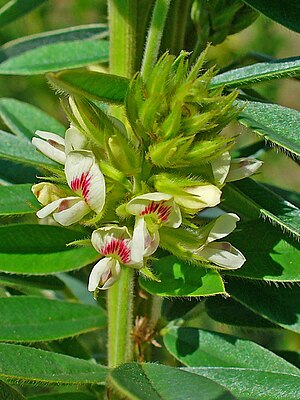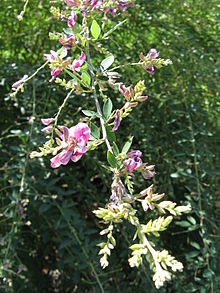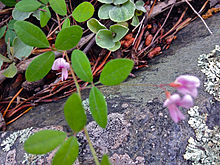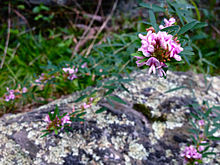Bush clover
| Bush clover | ||||||||||||
|---|---|---|---|---|---|---|---|---|---|---|---|---|

|
||||||||||||
| Systematics | ||||||||||||
|
||||||||||||
| Scientific name | ||||||||||||
| Lespedeza | ||||||||||||
| Michx. |
Bush clover ( Lespedeza ) is a genus in the subfamily Schmetterlingsblütler (Faboideae) within the family Leguminosae (Fabaceae). The 40 to 60 species are distributed in East and Southeast Asia from the Himalayas via China and Japan to Australia , as well as in North America .
description

Appearance and leaves
Bush clover species are herbaceous plants , semi-shrubs or deciduous shrubs , often with creeping or drag-like overhanging branches. The bark is sometimes hairy downy. The alternately arranged leaves are unpaired, pinnate in three parts.
Inflorescences, flowers and fruits
Lateral racemose or bundle inflorescences are formed. Two flowers each stand over a durable bract . There are two small leaflets at the tip of the peduncle . The hermaphrodite, zygomorphic flowers are five-fold with a double flower envelope . The five sepals are only briefly fused, bell-shaped, the one with five sepals . The corolla has the typical shape of a butterfly flower. The flag is oblong to obovate. The shuttle is bent upwards and ends bluntly. The nailed (abruptly narrowed at the base) wings are elongated, eyelet and they adhere to the shuttle. Nine of the ten stamens have grown together.
The lonely legume does not open.

Systematics
The genus Lespedeza belongs to the subtribe Lespedezinae from the tribe Desmodieae in the subfamily Faboideae within the family Fabaceae . A synonym for Lespedeza Michx. is Despeleza Nieuwl.
The French botanist, traveler and plant collector André Michaux gave the genus its name in honor of the Spanish governor of Florida, Vincente Manuel de Céspedes (1746-1802). Since an 'L' was transferred instead of the first letter 'C', the name Lespedeza was created .
There are around (40 to) 60 types of Lespedeza (selection):
- Lespedeza angustifolia (Pursh) Elliott : It occurs in the eastern United States.
- Bi-colored bush clover ( Lespedeza bicolor Turcz. ): It is Japan , Korea , Russia , Inner Mongolia and the Chinese provinces of Anhui , Fujian , Gansu , Guangdong , Guangxi , Hebei , Heilongjiang , Henan , Hunan , Jiangsu , Jilin , Liaoning , Shaanxi , Shandong , Shanxi as well as Zhejiang and perhaps in Mongolia.
- Lespedeza buergeri Miq. : It occurs in the Chinese provinces of Anhui, Gansu, Henan, Hubei, Jiangsu, Jiangxi, Shaanxi, Shanxi, Sichuan, Zhejiang and in Japan.
- Lespedeza capitata Michx. : It iswidespreadin North America in Canada and in the USA.
- Lespedeza caraganae Bunge : It thrives on mountain slopes below 1,400 meters in the Chinese provinces of Gansu, Hebei, Henan, Liaoning, Shaanxi , Shandong and perhaps Inner Mongolia.
- Lespedeza chinensis G.Don : It occurs at altitudes below 2500 meters in the Chinese provinces of Anhui, Fujian, Guangdong, Hubei, Hunan, Jiangsu, Jiangxi, Sichuan, Zhejiang and in Taiwan .
- Chinese bush clover ( Lespedeza cuneata (Dum.Cours.) G.Don ): It occurs naturally in India , Pakistan , Nepal , Bhutan , Laos , Thailand , Afghanistan , Korea, China, Vietnam , Japan, Indonesia , Malaysia and the Philippines . For example, it is a neophyte in North America and Australia .
- Lespedeza cyrtobotrya Miq. : It occurs in Japan, Korea, Russia and in the Chinese provinces of Gansu, Guangdong, Hebei, Heilongjiang, Henan, Jiangxi, Jilin, Liaoning, Shaanxi, Shanxi and Zhejiang.
- Lespedeza daurica (Laxm.) Schindl. : It occurs from northeast China, Japan, Korea and Siberia to Mongolia and the extreme east Asia.
- Lespedeza davidii Franch. : It occurs in the Chinese provinces of Guangdong, Guangxi, Guizhou, Hunan, Jiangxi and Zhejiang.
- Lespedeza dunnii Schindl. : It occurs in China in the provinces of Anhui, Fujian and maybe also Zheijiang.
- Lespedeza elegans Cambess. : It is from Kashmir .
-
Lespedeza fasciculiflora Franch. : Depending on the author, there are two varieties or only the nominate form:
- Lespedeza fasciculiflora Franch. var. fasciculiflora : It thrives at altitudes of 1600 to 3000 meters in Tibet and in the Chinese provinces of western Sichuan and northwestern Yunnan.
- Lespedeza fasciculiflora var. Hengduanshanensis CJChen: You only thrives in dry valleys at altitudes from 1800 to 2600 meters in Tibet and Sichuan.
- Lespedeza floribunda Bunge : It occurs in Pakistan, India, China and Mongolia.
- Lespedeza fordii Schindl. : It thrives at altitudes below 800 meters in the Chinese provinces of Anhui, Fujian, Guangdong, Guangxi, Hunan, Jiangsu, Jiangxi and Zhejiang.
- Lespedeza forrestii Schindl. : It thrives at altitudes of 2200 to 2800 meters in the Chinese provinces of Sichuan and Yunnan.
- Lespedeza frutescens (L.) Hornem. : It is widespread in Canada and the USA.
- Lespedeza gerardiana Maxim. : It occurs in India, Pakistan, Nepal, Bhutan and Tibet.
- Lespedeza hispida (Franch.) T.Nemoto & H.Ohashi : It is common in India, Pakistan, Nepal, Tibet and Yunnan.
- Lespedeza hirta (L.) Hornem. : It occurs in Canada and the USA.
- Lespedeza homoloba Nakai : It occurs in Japan.
- Lespedeza inschanica (Maxim.) Schindl. : It occurs in the Chinese provinces of Anhui, Gansu, Hebei , Hubei , Hunan, Jiangsu , Liaoning , Nei Mongol , Shaanxi, Shandong , Shanxi, Sichuan, Yunnan, in Japan and Korea.
- Lespedeza japonica L.H.Bailey : It is only known from culture.
- Lespedeza juncea (L. f.) Pers. (Syn .: Lespedeza caraganae Bunge , Lespedeza cystoides Nakai , Lespedeza hedysaroides (Pall.) Kitag. , Lespedeza inschanica (Maxim.) Schindl. ): It occurs in Japan, Korea, in eastern Siberia, Russia's Far East, in Mongolia, in Inner Mongolia and in the Chinese provinces of Gansu, Hebei, Heilongjiang , Jilin, Liaoning, Shandong and Shanxi.
- Lespedeza leptostachya Engelm. : It occurs in Illinois, Iowa, Minnesota and Wisconsin.
- Lespedeza lichiyuniae T.Nemoto, H.Ohashi & T.Itoh : It thrives in mountain valleys and sunny mountain slopes at altitudes of mostly 500 to 1700 (200 to 3000) meters in the Chinese provinces of Anhui, Chongqing , Gansu, Guizhou, Henan, Hubei, Hunan, Jiangsu, Shaanxi, Sichuan and Yunnan. In Japan she is a neophyte.
- Lespedeza maximowiczii C.K. Schneid. : It occurs in Japan, Korea and in the Chinese provinces of Anhui, Henan and Zhejiang.
- Lespedeza melanantha Nakai : The home is Japan and Korea.
- Lespedeza mucronata Ricker : It only thrives in arid, sandy locations in the Chinese provinces of Fujian, Guangdong, Jiangxi and Zhejiang.
- Lespedeza patens Nakai : It occurs on the Japanese island of Honshu .
- Lespedeza pilosa (tuna) sieve. & Zucc. : It occurs in Japan, Korea, Tibet and in the Chinese provinces of Anhui, Fujian, Gansu, Guangdong, Guizhou, Hubei, Hunan, Jiangsu, Jiangxi, Shaanxi, Sichuan and Zhejiang.
- Lespedeza potaninii Vassilcz. : It occurs in the Chinese provinces of Gansu, Hebei, Henan, Jiangsu, Liaoning, Nei Mongol, Ningxia, Qinghai, Shaanxi, Shandong, Shanxi, Sichuan, Tibet and Yunnan.
- Lespedeza procumbens Michx. : It occurs in the USA.
- Lespedeza repens (L.) WPCBarton : It occurs in the USA.
- Lespedeza schindleri H.Lév.
- Lespedeza stuevei Nutt. : It occurs in the USA.
- Thunberg's bush clover ( Lespedeza thunbergii (DC.) Nakai ), including Lespedeza formosa (bird) Koehne : It comes with several subspecies in Anhui, Fujian, Gansu, Guangdong, Guangxi, Guizhou, Hebei, Henan, Hubei, Hunan, Jiangsu, Jiangxi , Shaanxi, Shandong, Sichuan, Yunnan, Zhejiang, Taiwan, India, Japan and Korea.
- Lespedeza tomentosa (tuna) sieve. ex Maxim. : It is widespread in India, Kashmir, Nepal, Pakistan, China, Japan, Korea, Russia and Mongolia.
- Lespedeza violacea (L.) Pers. : It occurs in eastern Canada and the USA.
- Lespedeza virgata (Thunb.) DC. : It occurs with at least two varieties in the Chinese provinces of Anhui, Fujian, Guizhou, Hebei, Henan, Hubei, Hunan, Jiangsu, Jiangxi, Liaoning, Shaanxi, Shandong, Shanxi, Zhejiang, Taiwan, Japan and Korea.
- Lespedeza virginica (L.) Britton : It is distributed from eastern Canada via the USA to northern Mexico.
swell
- Puhua Huang, Hiroyoshi Ohashi, Tomoyuki Nemoto: Lespedeza , p. 302 - online with the same text as the printed work , In: Wu Zheng-yi, Peter H. Raven & Deyuan Hong (eds.): Flora of China , Volume 10 - Fabaceae , Science Press and Missouri Botanical Garden Press, Beijing and St. Louis, 2010, ISBN 978-1-930723-91-7 . (Sections Description and Systematics)
Individual evidence
- ↑ a b c Walter Erhardt , Erich Götz, Nils Bödeker, Siegmund Seybold: The great pikeperch. Encyclopedia of Plant Names. Volume 2. Types and varieties. Eugen Ulmer, Stuttgart (Hohenheim) 2008, ISBN 978-3-8001-5406-7 .
- ↑ a b c d e f g h i j k l m n o p q r s t u v w x y z Puhua Huang, Hiroyoshi Ohashi, Tomoyuki Nemoto: Lespedeza , p. 302 - online with the same text as the printed work , In: Wu Zheng-yi, Peter H. Raven & Deyuan Hong (Eds.): Flora of China , Volume 10 - Fabaceae , Science Press and Missouri Botanical Garden Press, Beijing and St. Louis, 2010, ISBN 978-1-930723-91 -7 .
- ↑ Andreas Bärtels: Encyclopedia of the garden trees . Ulmer Verlag, Stuttgart 2001, ISBN 3-8001-3198-6 , pp. 378-379.
- ↑ a b c d e f g h i j k l m n o p q r s Lespedeza in the Germplasm Resources Information Network (GRIN), USDA , ARS , National Genetic Resources Program. National Germplasm Resources Laboratory, Beltsville, Maryland.
- ↑ Helmut Genaust: Etymological dictionary of botanical plant names. 3rd, completely revised and expanded edition. Birkhäuser, Basel / Boston / Berlin 1996, ISBN 3-7643-2390-6 , pp. 336, 384.
- ^ SI Ali: Lespedeza . In: Flora of Pakistan . S. 357 ( eFloras.org ).





